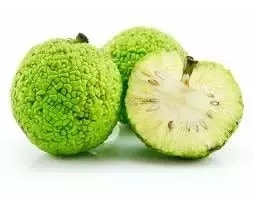Can You Eat Hedge Apples?
Last Updated on March 9, 2020 by Duncan
Used as a decoration in the 18th and 19th centuries, the hedge apple, Osage-orange, or the horse apple is one of the most unusual yet common fruits in the United States.
Many find the fruit nuisance. It’s unpleasant to drive over; it secretes juices that stain wood, concrete, patio, and falls in large quantities making it hard to pick.
The fruits you don’t pick sit in the backyard and rot, giving off a nasty smell.
Over 13,000 years ago, it’s believed that woolly mammoths, grounds sloths, and other mammals that are now extinct ate the Osage-orange fruits, and the seeds passed through the animals’ digestive system undigested.
As the animals traveled around the United States, they expelled the seeds that sprouted everywhere.
Can you eat hedge apples?
Squirrels tear apart the hedge apple for its seeds (not the seeds), making it an anomaly among fruits.
If you are wondering if you can eat hedge apples, Jared Rydelek, a YouTuber who has carved a niche by tracking down rare fruits and trying them out, tried eating the Osage-orange.
In the video below, you can see him eating the Osage-orange. Jared notes that you can eat the fruit, but it doesn’t taste good, and it will most likely make you sick.
He compared the flavor of the fruit to that of a “watermelon rind.” The fruit produces plenty of oils that make the hand stick.
As he doesn’t like the taste of the fruit, he goes ahead and extracts the seeds from the fruit and eats them.
How to eat hedge apple seeds
- Slice the fruit into small pieces with a knife
- Soak the fruit to loosen the seeds
- Crush the soaked fruit with a glove
- Rinse the gunk off the seeds
- Dry the seeds on a towel
- You can eat the seeds raw or roast them. If roasting them, add oil and salt to them. Roast them at 300 degrees for 10-15 minutes.
The seeds taste somewhere between popcorn and sunflower seed. They also have a nutty like a grainy taste to them.
Is eating Osange-range seeds worth it?
The process of preparing the seeds is tedious, and you end up with just a few seeds. After a multi-day work, Jared produced just a single bowl of hedge apple seeds.
If you have the apples in your yard, you are better off picking them up and disposing of them.
Unless you are looking to try out something new, there is no reason you should try eating Osage-orange seeds.
Do hedge apples repel insects?
The fruits rose to fame when people started saying that they repel insects.
People claim that placing the hedge apples around the foundation or inside the basement of the house will repel crickets, spiders, boxelder bugs, and other insects.
A study by Iowa State University showed that the chemicals extracted from the fruit are effective at repelling mosquitoes, German cockroaches, and houseflies but in highly concentrated forms.
Sliced pieces of the fruit placed in enclosed areas also did expel insects.
While this is the case, there is still no scientific study that shows that placing the entire fruit around the house in the basement will repel or affect the insects.
The study found that there is little concentration of the repellant chemical in the fruit, and in large, open space with a lot of air movement, the chemical is bound to dissipate quickly.
In addition to this, the chemical might not be repellant to all insects or non-insects such as millipedes and centipedes.
After the completion of the study, the university responded that it doesn’t recommend the use of the hedge apples for pest control.
If you still choose to go ahead and use them, you should be cautious of the milky juice present in the stems and fruit of the fruit that is known to cause skin irritation.
Using the Osage-orange in fencing
For years, Osage-orange has been used for fencing purposes.
The wood from the fruit is golden yellow or bright orange and is very durable and is not only highly effective at making fence posts; you can use it to make high-quality treenails, pieces of furniture, insulator pins, and archery bows.
When you allow it to dry out, the wood burns hot and long. It has one of the highest BTU ratings making it ideal for both indoor and outdoor cooking.
Osage-orange in home landscaping
Although, the hedge apple is popular in Iowa, it’s not a good tree when it comes to home landscaping. This is due to its large fruit and sharp thorns.
Plenty of studies have been done to come up with male thornless cultivars, but horticulturists are yet to come up with an utterly thornless variety.
Unless the scientists find the thornless cultivar, the Osage-orange is only best suited for wildlife plantings in the rural areas.
Conclusion
The hedge apple is best suited for fencing. Its ability to withstand strong winds, extreme heat, and unhealthy soil makes it an excellent windbreaker and cattle deterrent.
For centuries, the hedge apples haven’t been an essential source of food for wildlife as most birds and animals find them unpalatable, and things should remain the same.
While you can eat the hedge apple seeds without any health risk, the process of preparing them is long and not worth it.
As mentioned above, unless you are into trying out unique foods, there is no reason you should waste your time and resources preparing the seeds for eating.
When the Osage-oranges fall in your backyard, pick them up and dispose of them. Maybe the squirrels will find them, and since they have all the time in the world to remove the seeds, let them have a go at them.
